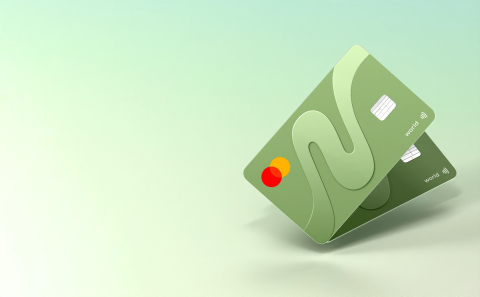5 Things to Know About the Ness Card
This wellness-focused card comes with a hefty annual fee and caters to those who prioritize health-related purchases, regardless of price.

Many or all of the products on this page are from partners who compensate us when you click to or take an action on their website, but this does not influence our evaluations or ratings. Our opinions are our own.
» This story is out of date
In November 2023, the CEO and founder of Ness announced that the Ness Card was shutting down. See NerdWallet's best credit cards for wellness for other options.
The Ness Card, issued by The Bank of Missouri, is a premium card — with a premium annual price tag — geared toward those who spend serious bucks on self-care. You can earn rewards points through physical activity or by making eligible health and wellness purchases and redeem rewards toward fitness clothing, gear, classes, food and more.

Image courtesy of Ness
It’s not the first wellness card to try to get consumers’ hearts palpitating. The Paceline Card — which was discontinued in February 2023 but is now apparently set for a relaunch — also tied rewards to physical activity. But that was a cash-back card, while the Ness Card’s redemption options include a rotating selection of participating merchants. (The KrowdFit credit card, too, promises wellness-related cash-back rewards.)
The Ness Card is currently in public beta, meaning it’s available to anyone who qualifies, but card features may change (and you may notice some bugs) as the product evolves. And to potentially qualify, according to a Ness representative, you need a credit score of 680 or higher based on the VantageScore 4.0 scoring model.
Here are five things to know about the Ness Card.
1. The annual fee might leave you winded
The Ness Card costs a sweat-inducing $349 per year. That’s the kind of annual fee you typically pay for high-end travel rewards cards with loads of valuable perks. This card does offer statement credits and discounts at partnering merchants, which can help offset the cost.
The easiest-to-maximize benefit is its automatic $200 annual credit toward “healthy spending,” which includes broad categories like grocery stores, gym memberships, drugstores and more.
The card also touts more than $2,000 worth of credits at participating merchants. For example, as of this writing, you can get up to $360 in credits at Sweetgreen, a fast-casual salad spot with locations in 17 states and Washington, D.C. That would more than cover the annual fee on its own, but to get the most out of this credit, you must spend $150 at Sweetgreen per month. That translates to buying 10 to 15 salads, depending on what you order and which location you order from, to get $30 back per month. That’s a lot of kale.
Point being, using these coupon book-style credits means you have to spend lots of money to save a little money. If you shop at Ness’ partner merchants already, you can use the Ness Card to your advantage and score some discounts. If you don’t, you’re less likely to get value out of this card.
2. You can earn high rewards rates on wellness purchases
There are three ways to earn points on the Ness Card:
A welcome offer
New cardholders can earn a sign-up bonus: 50,000 points if you spend $6,000 in the first 90 days.
Earn on purchases
The base rewards rate for all purchases is 2 points per $1, but you’ll earn 5 points per $1 at qualifying health and wellness merchants. These include:
Food. Grocery stores and healthy restaurants.
Fitness. Apparel, gym memberships, fitness classes, personal training, sporting goods, and recreational camps and activities.
Health care. Medical, dental and vision providers, drugstores and counseling services.
Cosmetics. Including personal care items, spa services or cosmetic medical services like Botox.
Outdoor activities. Campgrounds and national parks.
Target, Costco, Walmart and Amazon purchases are not considered part of the health and wellness category. If you make a purchase you’d like to be considered for the higher rewards rate, you can request that Ness review it to see whether you'll be granted extra points.
Earn through physical activity
Exercise, sleep and mindfulness activities like meditating can also earn up to 56 points per day. To earn points this way, you must connect Apple Health to the Ness Card app. Only data from an iPhone or Apple Watch can be counted — other fitness trackers don’t work with the Ness app.
3. Redemption is limited to specific merchants
Redeeming for cash back is an option, but your points will be worth only half a cent each when used this way. You’ll get double the value, 1 cent per point, when you redeem for merchandise and experiences through the Ness Card Rewards Marketplace.
Available redemption options are subject to change over time.
4. It’s actually a charge card
Unlike revolving credit cards, which allow you to carry a balance (with interest) from one month to the next, the Ness Card is a charge card. That means you must pay the entire balance in full every month, and there are no interest charges.
If you make a late payment, you’ll be charged a $29 late fee the first time. Miss another payment due date within the next six billing cycles and you’ll be charged a $39 fee. If you make two consecutive late payments in a row, the late fee will be $39 or 1.99% of the unpaid balance, whichever is greater.
5. It’s only for iPhone users right now
You manage your card and rewards in the Ness app, which is only available on iPhones running iOS 14 or later. The Ness app is not available on Android devices. You can, however, add your card to Apple Pay, Google Pay or Samsung Pay.
Find the right credit card for you.
Whether you want to pay less interest or earn more rewards, the right card's out there. Just answer a few questions and we'll narrow the search for you.

